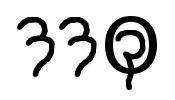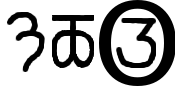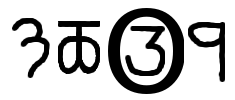Seuna units
The units for weight, height, distance and time are all derived from properties of the earth.
p
p
p
p
u
u
u
u
u
u
p
p
p
p
Weight
The most used unit of weight can be said to be 2.47kg (not exact). It is pronounced hi but written with the letter "h" of the Seuna alphabet. Actually hi is not a unit of weight as such but just an exponent in the Seuna numbering system, meaning 8-27. In full 2.47kg should be called 1h "earthweight". But usually the last part is missed out and hi is usually taken as a unit of weight.
Height
The most used unit of height can be said to be 4.77cm (not exact). It is usually just pronounced ji and written with the letter "j" of the Seuna alphabet. Actually ji is not a unit of height as such but just an exponent in the Seuna numbering system, meaning 8-9. In full 4.77cm should be called 1j "earthheight". But usually the last part is missed out and ji is usually taken as a unit of height. One "earthheight" is the polar radius.
Distance
The most used unit of distance can be said to be 78.3km (not exact). It is usually just pronounced mi and written with the letter "m" of the Seuna alphabet. Actually mi is not a unit of distance as such but just an exponent in the Seuna numbering system, meaning 8-3. In full 78.3km should be called 1m "earthdistance". But usually the last part is missed out and mi is often taken as a unit of distance in certain situations : such as talking about the distance between two cities. It is not so strongly associated with the unit of distance, as h is associated with the unit of weight and j is associated with the unit of height. One "earthdistance" is the equatorial circumference.
Area
In a similar manner to the above when taking about the floor area of houses or plot sizes for houses, the exponent pi is used, which is around 14.5m2. When taking of field sizes, the exponent fi is used, which is around 7422m2. One "eartharea" is the total surface area of the earth of course.
Temperature
The unit temperature is taken as 65.263 degrees Kelvin. This is not taken from any fundamental measurement of the earth or anything, but simply to give us a convenient scale for talking about everyday temperatures. It does however fix the normal temperature of the human body(37 Celcius) at exactly 4.6 units.
4 units is -12 Celcius 5 units is 53 Celcius
Outside of scientific usage, it is rare to get temperature outside the range -12 to 53 Celcius. So as to weather, people would say "tomorrow will be .45" and not "tomorrow will be 4.45".
Time
Here we are talking about time during the day. For longer periods of time you should refer to the Calendar section.
The unit of time is equal to 24 hours. The day begins at six o'clock in the morning. To make appointments, people say "I will meet you at .544" or just "I will meet you at 544"(acailaula). Note that between .544 and .545 is 2.8 minutes so to say "I will meet you at 544" is ecurate enough for arranging human affairs.
For describing approximately when something happened during the day, we have eight periods : "pre"abai, abaia, agaia, adaia, alaia, acaia, asaia and akaia. Each of these time periods is equivalent to three hours. They can be further defind by the prefix "early", "mid" and "late". So "mid"adaia defines a time from 4 o'clock in the afternoon to five o'clock at night.
The word for midday is simply agai. The word for midnight is simply asai. These can be given the prefixes "pre" and "post" to divide the day into four periods. 6 o'clock in the morning is called ??. There are also terms for sunup/dawn and sundown as these vary with time of year and with latitude.
The name for the period that the sun is up is ai"day" The name for the period that the sun is down is hau"day" The name for the period 6 a.m. to 6 p.m. is hai"day" The name for the period 6 a.m. to 6 p.m. is au"day"
Speed
The fundamental unit of speed is 78.3km/24hours or 3.2625 km/hour. This is about .9 m/sec.
Index
- Introduction to Seuna
- Seuna : Chapter 1
- Seuna word shape
- The script of Seuna
- Seuna sentence structure
- Seuna pronouns
- Seuna nouns
- Seuna verbs (1)
- Seuna adjectives
- Seuna demonstratives
- Seuna verbs (2)
- Asking a question in Seuna
- Seuna relative clauses
- Seuna verbs (3)
- Methods for deriving words in Seuna
- List of all Seuna derivational affixes
- Numbers in Seuna
- Naming people in Seuna
- The Seuna calendar
- Seuna units


